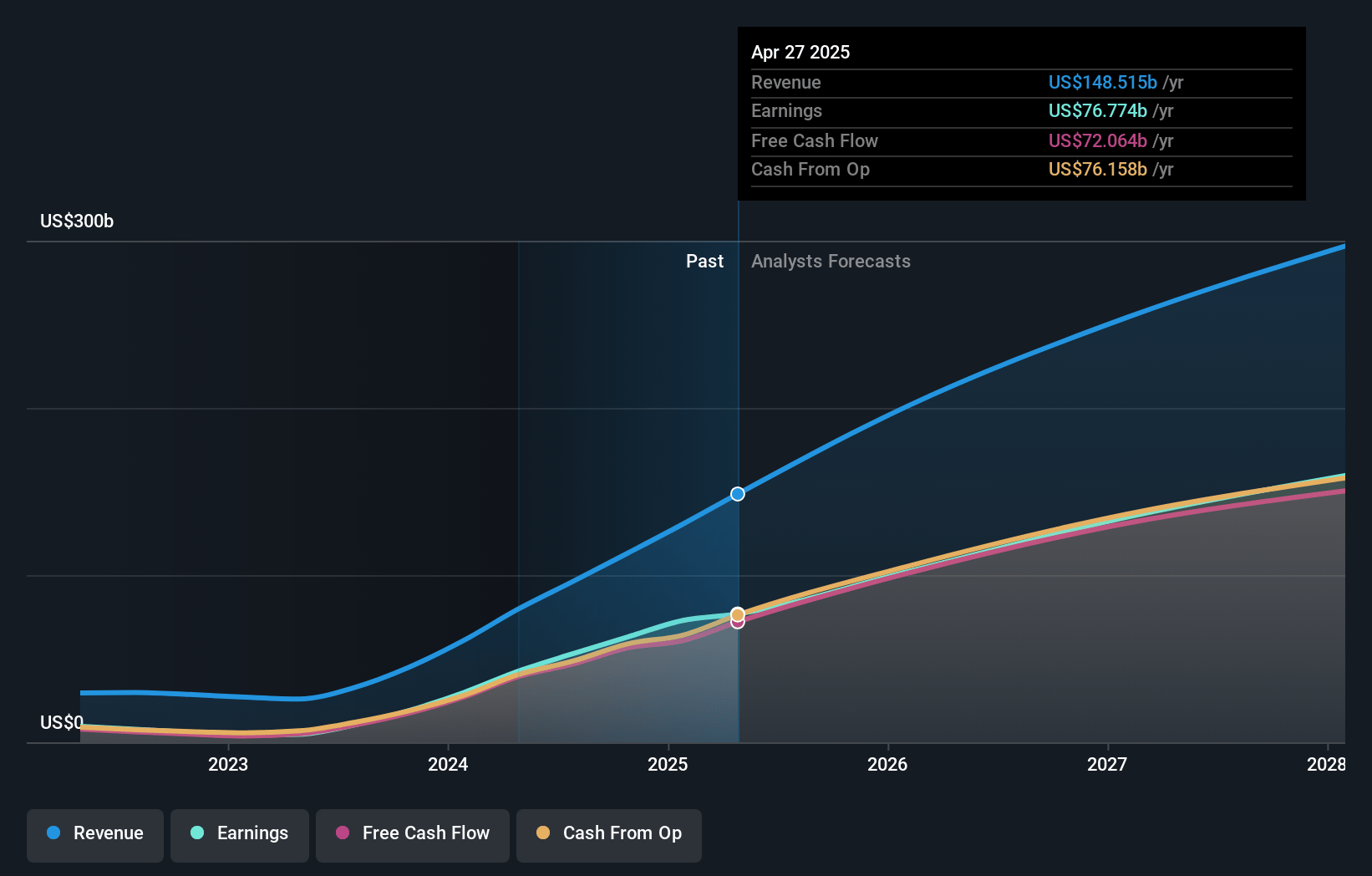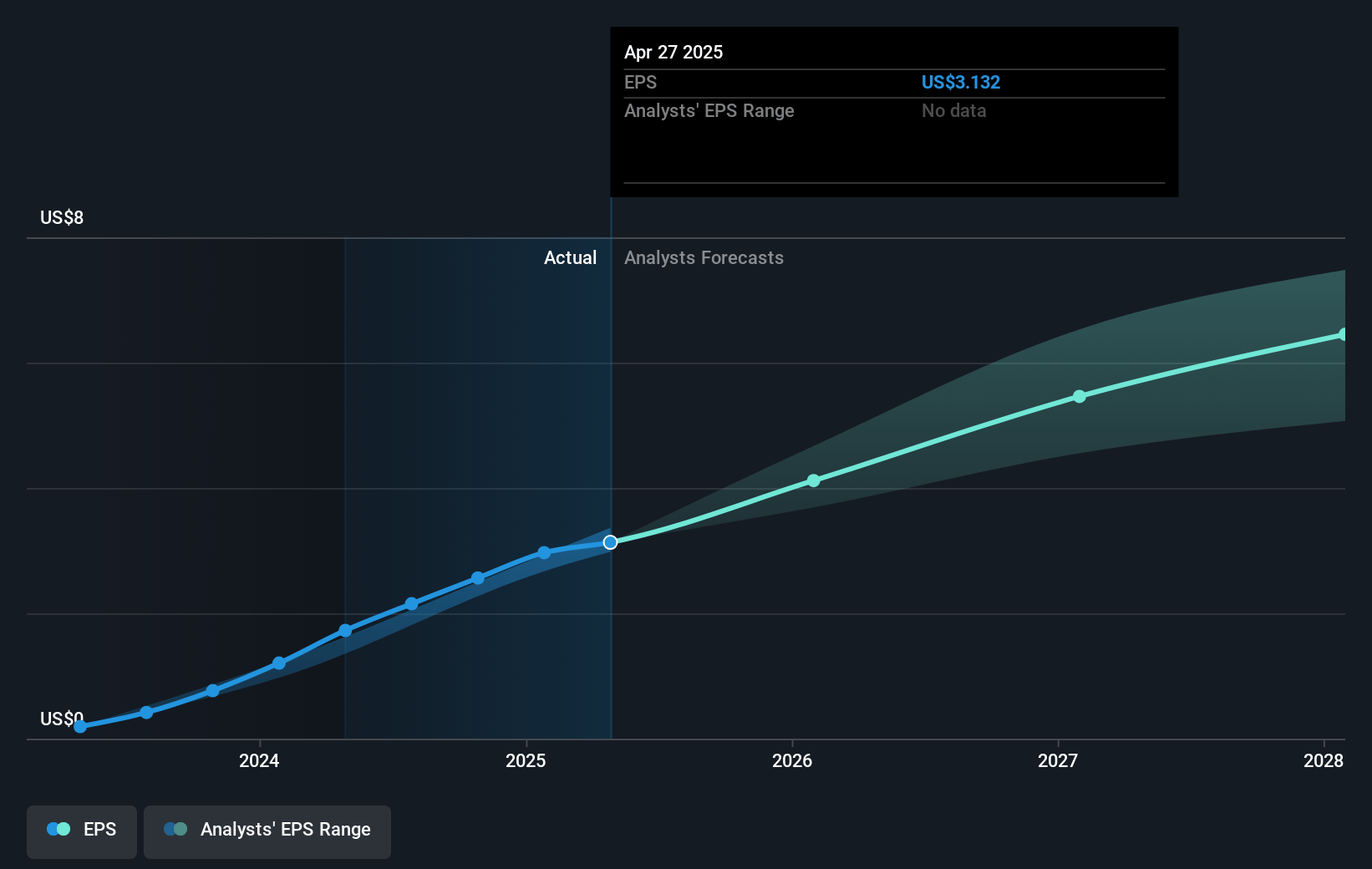Key Takeaways
- Blackwell architecture and AI model scaling focus position NVIDIA for growth in data center and AI workloads, enhancing revenue and margin potential.
- Expansion into autonomous vehicles and new GPU products indicates future revenue streams and market share growth across gaming and automotive sectors.
- U.S. regulatory issues, China restrictions, and Blackwell system costs present significant challenges to NVIDIA's growth, profitability, and diversification efforts.
Catalysts
About NVIDIA- A computing infrastructure company, provides graphics and compute and networking solutions in the United States, Singapore, Taiwan, China, Hong Kong, and internationally.
- NVIDIA's Blackwell architecture is expected to drive significant growth, as it supports reasoning AI models that require much more compute capacity, potentially increasing NVIDIA's revenue from data center sales by providing a competitive edge in next-generation AI capabilities.
- The company's strategic focus on inference time scaling and test-time scaling of AI models positions NVIDIA to capture a larger share of AI workloads, which could improve earnings as enterprise and cloud services expand infrastructure investments in NVIDIA's technology.
- NVIDIA's ability to ramp up production of the Blackwell architecture quickly to meet overwhelming demand demonstrates operational efficiency, which could positively impact net margins by optimizing manufacturing and scaling capabilities.
- The development of NVIDIA's end-to-end autonomous vehicle platform and partnerships with major automotive companies like Toyota and Uber signal a future revenue stream from the automotive sector's rapid adoption of AI, likely boosting NVIDIA's overall revenue growth.
- NVIDIA's deployment of GeForce RTX 50 Series GPUs and professional visualization products showcase continued innovation in its gaming and enterprise sectors, likely enhancing revenue from multiple verticals and possibly increasing market share in high-margin areas.
NVIDIA Future Earnings and Revenue Growth
Assumptions
How have these above catalysts been quantified?- Analysts are assuming NVIDIA's revenue will grow by 30.1% annually over the next 3 years.
- Analysts assume that profit margins will shrink from 55.8% today to 55.1% in 3 years time.
- Analysts expect earnings to reach $158.2 billion (and earnings per share of $6.38) by about April 2028, up from $72.9 billion today. However, there is a considerable amount of disagreement amongst the analysts with the most bullish expecting $237.5 billion in earnings, and the most bearish expecting $126.4 billion.
- In order for the above numbers to justify the analysts price target, the company would need to trade at a PE ratio of 31.9x on those 2028 earnings, down from 33.1x today. This future PE is greater than the current PE for the US Semiconductor industry at 22.3x.
- Analysts expect the number of shares outstanding to decline by 0.81% per year for the next 3 years.
- To value all of this in today's terms, we will use a discount rate of 8.81%, as per the Simply Wall St company report.
NVIDIA Future Earnings Per Share Growth
Risks
What could happen that would invalidate this narrative?- Gross margins are currently in the low 70s due to the expedited manufacturing focus on the Blackwell systems, which could impact net margins if not improved as expected later in the year.
- U.S. regulatory uncertainties, including potential new tariffs, could impact revenue growth and profitability, especially considering the mix shift towards the U.S. market.
- China revenues remain constrained by export controls, posing a risk to NVIDIA's geographic diversification and impacting overall revenue stability.
- The complexity and cost of the Blackwell systems, including over 1.5 million components and numerous manufacturing sites, could lead to increased operating expenses, affecting earnings.
- The ongoing focus on ramping Blackwell could overshadow or delay other innovations, affecting NVIDIA's long-term revenue diversification beyond the AI market.
Valuation
How have all the factors above been brought together to estimate a fair value?- The analysts have a consensus price target of $164.736 for NVIDIA based on their expectations of its future earnings growth, profit margins and other risk factors. However, there is a degree of disagreement amongst analysts, with the most bullish reporting a price target of $220.0, and the most bearish reporting a price target of just $115.0.
- In order for you to agree with the analyst's consensus, you'd need to believe that by 2028, revenues will be $287.2 billion, earnings will come to $158.2 billion, and it would be trading on a PE ratio of 31.9x, assuming you use a discount rate of 8.8%.
- Given the current share price of $98.89, the analyst price target of $164.74 is 40.0% higher.
- We always encourage you to reach your own conclusions though. So sense check these analyst numbers against your own assumptions and expectations based on your understanding of the business and what you believe is probable.
How well do narratives help inform your perspective?
Disclaimer
Warren A.I. is a tool utilizing a Large Language Model (LLM) that ingests data on consensus price targets, forecasted revenue and earnings figures, as well as the transcripts of earnings calls to produce qualitative analysis. The narratives produced by Warren A.I. are general in nature and are based solely on analyst data and publicly-available material published by the respective companies. These scenarios are not indicative of the company's future performance and are exploratory in nature. Simply Wall St has no position in the company(s) mentioned. Simply Wall St may provide the securities issuer or related entities with website advertising services for a fee, on an arm's length basis. These relationships have no impact on the way we conduct our business, the content we host, or how our content is served to users. The price targets and estimates used are consensus data, and do not constitute a recommendation to buy or sell any stock, and they do not take account of your objectives, or your financial situation. Note that Warren A.I.'s analysis may not factor in the latest price-sensitive company announcements or qualitative material.







